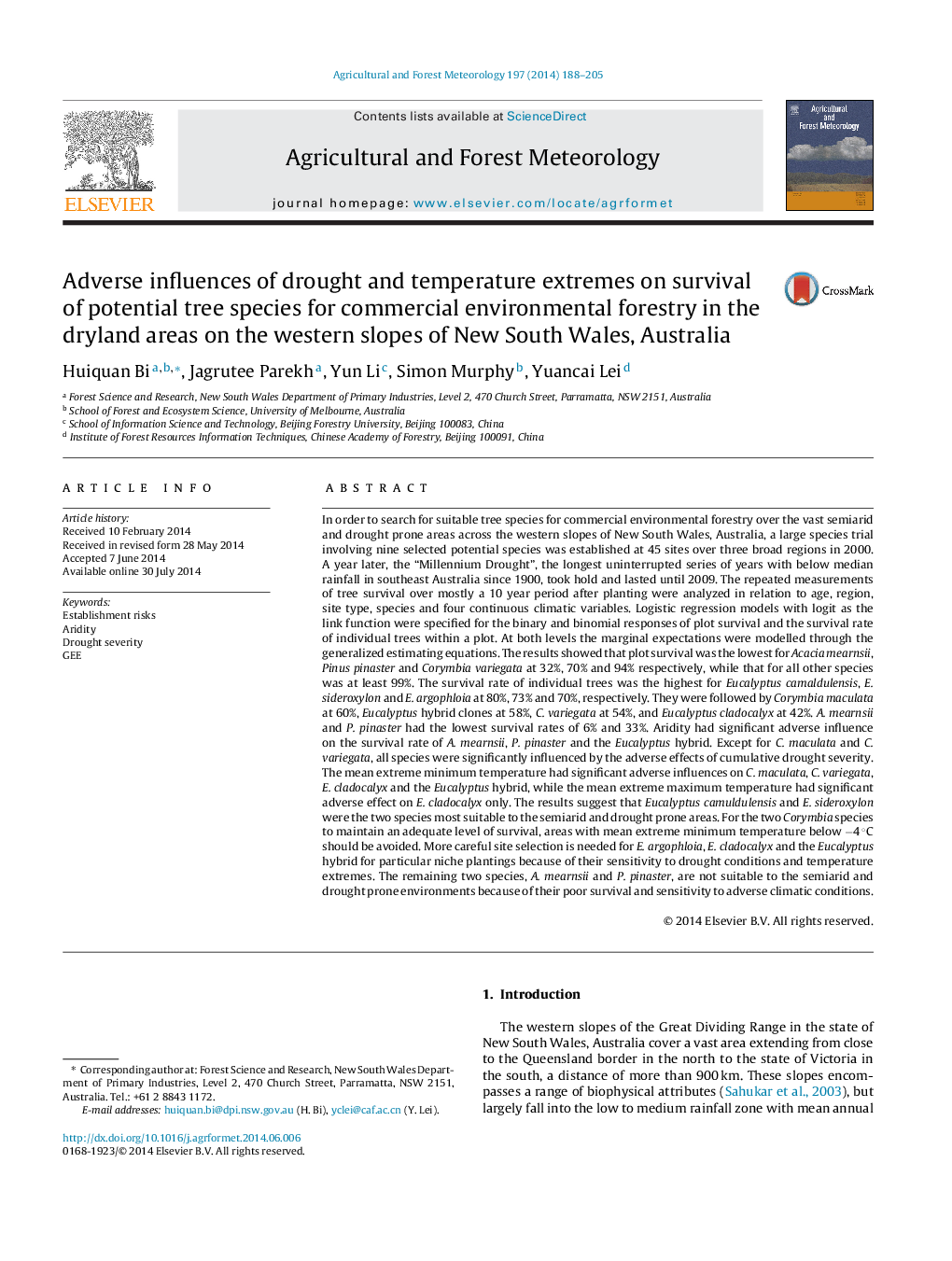| کد مقاله | کد نشریه | سال انتشار | مقاله انگلیسی | نسخه تمام متن |
|---|---|---|---|---|
| 81714 | 158332 | 2014 | 18 صفحه PDF | دانلود رایگان |
• A large trial of 9 tree species over 45 sites experienced the “Millennium Drought”.
• Longitudinal binary and binomial tree survival data were analyzed through GEE.
• Aridity, drought severity and temperature extremes had adverse effects on survival.
• Eucalyptus camuldulensis and E. sideroxylon are the most suitable species.
• Commercial environmental forestry faces high establishment risks in semiarid areas.
In order to search for suitable tree species for commercial environmental forestry over the vast semiarid and drought prone areas across the western slopes of New South Wales, Australia, a large species trial involving nine selected potential species was established at 45 sites over three broad regions in 2000. A year later, the “Millennium Drought”, the longest uninterrupted series of years with below median rainfall in southeast Australia since 1900, took hold and lasted until 2009. The repeated measurements of tree survival over mostly a 10 year period after planting were analyzed in relation to age, region, site type, species and four continuous climatic variables. Logistic regression models with logit as the link function were specified for the binary and binomial responses of plot survival and the survival rate of individual trees within a plot. At both levels the marginal expectations were modelled through the generalized estimating equations. The results showed that plot survival was the lowest for Acacia mearnsii, Pinus pinaster and Corymbia variegata at 32%, 70% and 94% respectively, while that for all other species was at least 99%. The survival rate of individual trees was the highest for Eucalyptus camaldulensis, E. sideroxylon and E. argophloia at 80%, 73% and 70%, respectively. They were followed by Corymbia maculata at 60%, Eucalyptus hybrid clones at 58%, C. variegata at 54%, and Eucalyptus cladocalyx at 42%. A. mearnsii and P. pinaster had the lowest survival rates of 6% and 33%. Aridity had significant adverse influence on the survival rate of A. mearnsii, P. pinaster and the Eucalyptus hybrid. Except for C. maculata and C. variegata, all species were significantly influenced by the adverse effects of cumulative drought severity. The mean extreme minimum temperature had significant adverse influences on C. maculata, C. variegata, E. cladocalyx and the Eucalyptus hybrid, while the mean extreme maximum temperature had significant adverse effect on E. cladocalyx only. The results suggest that Eucalyptus camuldulensis and E. sideroxylon were the two species most suitable to the semiarid and drought prone areas. For the two Corymbia species to maintain an adequate level of survival, areas with mean extreme minimum temperature below −4 °C should be avoided. More careful site selection is needed for E. argophloia, E. cladocalyx and the Eucalyptus hybrid for particular niche plantings because of their sensitivity to drought conditions and temperature extremes. The remaining two species, A. mearnsii and P. pinaster, are not suitable to the semiarid and drought prone environments because of their poor survival and sensitivity to adverse climatic conditions.
Journal: Agricultural and Forest Meteorology - Volume 197, 15 October 2014, Pages 188–205
